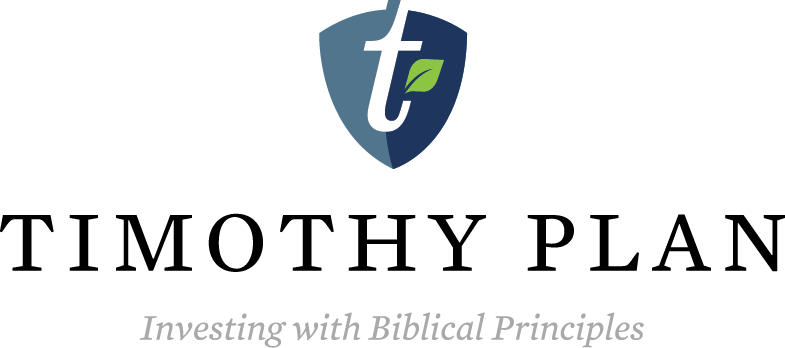Large/Mid Growth 2Q19
July 30, 2019
Recent Posts
- A Businessman Who Really Did Give it All Over to GodSeptember 28, 2022
- A 'Screwtape' Approach to Keeping Christians from Biblically Responsible InvestingSeptember 21, 2022
- Both Inflation and Inaction Are UnbiblicalSeptember 14, 2022
- Misunderstood in the NeighborhoodAugust 18, 2022
- Billy Graham was the inspiration for the new BiblegraphAugust 9, 2022
- A Businessman Who Really Did Give it All Over to God
Categories

Investing involves risk, including the potential loss of principal.
Before investing, carefully consider the fund’s investment objectives, risks, charges, and expenses of the investment company. This and other important information can be found in the fund’s prospectus. To obtain a copy, visit TIMOTHYPLAN.COM or call 800.846.7526. Read each prospectus carefully before investing.
Because the Timothy Plan Funds do not invest in excluded securities, the Funds may be riskier than other funds that invest in a broader array of securities. There are risks when a fund limits its investments to particular sized companies, and all companies are subject to market risk. The Fund recently experienced significant negative short-term performance due to market volatility associated with the Covid-19 pandemic.
MUTUAL FUND INVESTOR
To read more about our mutual funds, please click this link to access fund information, including the prospectus, fact sheets, performance, and holdings for each fund.A prospectus is available from the Fund or your financial professional that contains more complete, important information. Please read it carefully before investing. Mutual Funds distributed by Timothy Partners, Ltd. Member FINRA.
HEADQUARTERS: 1055 Maitland Center Commons, Maitland, FL
(800) 846-7526 | Send an email | View our mapMUTUAL FUND SHAREHOLDER SERVICES: c/o Ultimus Fund Solutions, Post Office Box 541150, Omaha, NE 68154-1150
(800) 662-0201 | Account AccessETF INVESTOR
To read more about our ETFs, please click this link to access fund information, including fact sheets, performance and holdings for each fund. A prospectus is available from the Fund or your financial professional that contains more complete, important information. Please read it carefully before investing. ETFs distributed by Foreside Fund Services, LLC, Member FINRA. Timothy Partners, Ltd. is not affiliated with Foreside Fund Services, LLC.
ETF SHAREHOLDER SERVICES: Contact your financial advisor for information regarding your account.






Macroeconomic Update
Trade tariff s, threats of additional trade tariff s, and the uncertainty regarding the ultimate resolution of the issues underlying the trade tariff s are having meaningful impacts on economic growth around the world. In the US, in the aggregate, the impacts are putting the brakes on Gross Domestic Product (GDP) growth. After upward revisions to the first quarter GDP expansion to 3.1%, fueled mainly by inventory building and export pre-buying ahead of the first round of tariff imposition, growth slowed markedly in the second quarter. As of July 3, 2019 the Atlanta Federal Reserve’s GDPNowTM (Federal Reserve Bank of Atlanta, Center for Quantitative Research) estimates second quarter 2019 growth at 1.5%. That will most likely be revised upward following a stronger than expected June employment report but will likely remain 2.0% or below following the revision. Interestingly, the tariff s are divulging a dichotomy in tariff response between business and consumer. On the supply side, businesses appear to have grown more cautious. Although both the Institute for Supply Management Manufacturing and Non-Manufacturing (services) indices (June 2019 Manufacturing ISM® Report On Business®, June 2019 Non-Manufacturing ISM® Report On Business®) registered continuing expansion readings, both weakened as the quarter progressed. The ISM Manufacturing index hit its lowest level since October 2016 and the ISM® Non-Manufacturing (services) index, which represents two-thirds of the domestic economy, fell to its lowest level in nearly two years. Of concern, the New Order sub-component of the ISM Manufacturing index registered a reading of 50, which is the tipping point between expansion and contraction. That is the lowest level since December 2015.
In contrast, on the demand side of the economy the negative impacts of tariff s are a bit more difficult to discern. While the University of Michigan Consumer Sentiment index (Survey of Consumers© The University of Michigan, 2019) trended down during the quarter, it remains elevated. Consumers remain on solid ground as employment gains, while softening, remain at healthy levels overall. The quarterly average monthly employment gain of 170,000 during the second quarter of 2019, down from 180,000 during the first quarter and 233,000 in the fourth quarter of 2018, is indicative of slowing growth but wage gains and average hours worked remain generally steady. It should be noted that the final round of proposed US tariff s on Chinese goods, which would have finally directly affected consumer products imports, have been postponed for the time being. Future implementation would have a material impact on our outlook for consumer spending.
Q2 2019 Review
The markets continue to favor larger cap growth stocks over smaller cap names and like last quarter, growth stocks are still trumping value names across all capitalizations. Technology, Consumer Discretionary and Financial Services stocks were strong, while Energy names faltered as oil prices declined. Notable this quarter, the Russell indices rebalanced at the end of June and in the Russell 1000 Growth Index, the Technology weight is now 37%, which is the highest level since the Technology bubble in the early 2000’s.
Large/Mid Growth fell short of the Russell 1000 Growth Index by 0.80%, returning +3.8% versus the benchmark +4.6%. Sector allocation was mildly negative; the primary detraction from performance was stock picks in the Consumer Discretionary sector. Lowe’s (3.4%) 1 and O’Reilly Automotive (2.0%) fell 5-7%, while the benchmark sector was up 6.6%. Our best selection came within Health Care – here Sarepta Therapeutics (0.9%) rose +27%, animal-health company Zoetis (2.3%) was up +13% and Insulet (0.7%) gained +25%.
Contributors
CDW Corp. (2.9%; +15.5%)is a technology solutions provider and reseller of equipment, operating through segments that serve corporate, small business, and public customers. The stock has performed well as the company continues to produce revenue gains greater than that of the underlying U.S. IT spend rates. This has allowed the company to consistently deliver mid to high-single-digit annual revenue growth and double-digit EPS growth. Management has aligned with faster growing emerging products/solutions, like cloud and SaaS (software as a service), and margin expansion has been driven by a higher mix of solutions sales.
Rapid7 Inc. (2.6%; +14.2%) has gained 85% this year as the company’s cloud SAAS security offerings continue to be in high demand. Enterprise customers continue to invest in Rapid7’s core market, Vulnerability Management. Rapid7 has one of the strongest software solutions to provide automated protection against intrusion for these corporate clients.
Detractors
Palo Alto Networks (1.5%; -16.0%) provides network security solutions to enterprises, services providers, and government entities. While the company beat expectations for revenue and earnings in the quarter, a miss on billings weighed on the stock. The billings miss was due to a shortening of a contract duration as well as fewer multi-year deals. This also resulted in a modest downward revision of EPS estimates for the upcoming quarter. We continue to believe that this will be a good longterm investment; network security is one of the most strategic, resilient, and rapidly growing areas of technology.
Lowe’s Companies (3.2%; -7.4%) is a big-box retailer of home-improvement products. The company had a messy quarter to say the least: a 9% EPS shortfall, gross margins down 160 basis points, inventories up 14%, and a 9% annual EPS guidance cut. Management cited cost pressures, merchandising organization transitions, and deficient pricing tools. The only positive in the quarter was a sales comparison of +4.2% in the U.S., ahead of Home Depot’s +3.0%. While we knew the company was in the midst of a turn-around, this is a setback, and we will be closely monitoring its upcoming results.
Market Outlook
In the second quarter, most of the “themes” in the market continued to play out in a directionally similar manner to Q1. Both sides of the US/China tariff stand-off alternated between taking a hard stance and indicating that they thought a deal can get done. At the G20 meeting on the last weekend of the quarter, Trump and Xi agreed to delay pending tariff increases while negotiations continue. Many believe that it is optimistic to think that a deal will get done well before year-end. The economic softness referred to in the “macro” section above has caused bond yields to take another leg down. The 10- year Treasury yield that dipped down to about 2.4% at the end of Q1 went slightly below 2.0% in the 2nd quarter and fi nished at 2.0% on 6/30/19. The members of the Fed, for their part, had already indicated that they would be on hold for some time (sparking last quarter’s rally), but then in the June press conference they went further and hinted at a possible rate cut. Chairman Powell said, “we will act as needed, including promptly if that’s appropriate.” Market bulls think this return to a “Fed-put” scenario will keep at least a floor on the markets and that an eventual China deal will provide additional upside. But with the market near recent highs and valuations above historical averages, arguably at least some of the positives are already discounted.
Portfolio positioning results primarily from bottom-up selection decisions but includes a small influence from our top-down economic outlook and sector prospects. We continue to find compelling investment opportunities within the large cap growth space and remain focused on generating alpha and producing the strongest investment results we can for you over the long run. We thank you for your continuing support and investment.
Please feel free to call or email us with any feedback or questions about the portfolio.
Manager views expressed herein were current as of the date indicated above and are subject to change. It should not be assumed that recommendations made in the future will be profitable or will equal the performance of the securities in this commentary. A copy of the calculation methodology and the full list of recommendations made in the preceding year is available upon request. The performance data quoted represents past performance and does not guarantee future results. Performance returns quoted are gross of fees which were calculated on a time weighted basis and do not give effect to investment advisory fees, which would reduce such returns. Please see Chartwell’s Form ADV, Part II for a complete description of investment advisory fees. The following statement demonstrates the compound effect advisory fees have on investment returns: For example, if a portfolio’s annual rate of return is 15% for 5 years and the annual advisory fee for a client is 100 basis points or 1.00%, the gross cumulative 5 year return would be 101.1% and the five year return net of fees would be 92.5%. Actual fees charged to portfolios may be different due to various conditions including account size, calculation method and frequency, and the presence of a performance or incentive fee. The deduction of performance and incentive based fees will have similar, yet often larger, impacts to performance and account values than standard management fees. To receive a complete list and description of Chartwell Investment Partners’ composites, performance attribution for all securities, and/or a presentation that adheres to the GIPS® standards, please contact Lynette Treible by phone (610)407-4870, email [email protected], or by mail to 1205 Westlakes Drive, Suite 100, Berwyn, PA 19312.